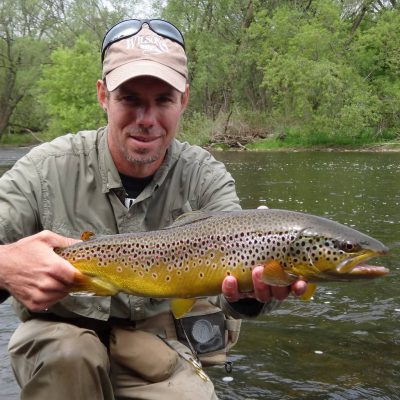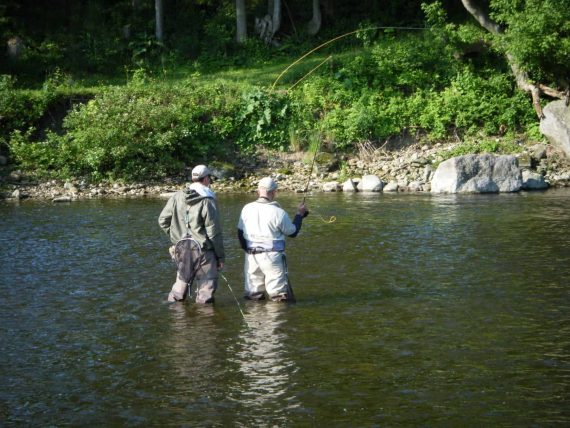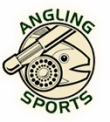So how do you fish Streamers on our rivers, fast, slow, or something in-between? Which is best, which will produce the most fish?
The Slooooow Method: Last year I was teaching a client some advanced streamer fishing tactics as we worked a long run down into the next pool. I just finished telling him many guys spend way to much time in the same spot because they don’t know how to cover the water effectively and sure enough two guys walk into the same run that we just fished and they started chucking streamers. About 40 minutes later we decided to head back up the river to the cars to grab some lunch. When we passes these same two guys they were still chucking streamers in the same spot 40 minutes after they started. During that time my client saw about four nice sized trout as we worked our way down the river from pool to pool. When I asked the one guy if he was having any luck, he said “no, it’s really tough today”. It’s common for guys to park themselves in a spot like this for way to long, fan casting, casting over and over again in the same spots, changing many different flies find that one special fly that’s going to finally make the big trout bite and maybe even changing up their retrieve speeds and all hoping for good results. In some cases, if they’re really lucky, they might catch a fish or two, but when you’re fishing streamers staying put in the same spot is often way less effective then moving and covering some water. Sure, there are times when I will make two or three casts in the same spot, but there has to be a very good reason for doing so. Sure, I’ll change a few flies to see what the big trout want to eat, and sure I’ll change up my retrieve speeds a bit to try and entice a big guy to bite, but I can do all that while moving and covering water. I rarely if ever spend 30 minutes or more in a spot when I streamer fish.

Moving and Covering Water: Moving a little faster up or down the river is much more productive and will allow you to cover more water and get your fly in front of more big hungry fish. That should be you’re game plan every time you streamer fish. But still, to often I see guys making multiple casts in the exact same spot and only then slowly moving up or down river a bit. They’re moving faster the then other two guys, but still not really that fast because of the multiple casts they are doing.
I’m known to say to my clients, ” hey, you know that’s 3 casts in the exact same spot right? If they didn’t eat it on the first cast, they aren’t going to eat it”, in a nice way of course. I’m never afraid to tell someone when they’re doing it wrong because wrong means less chance for big fish and if I don’t tell them when they’re not doing it right they don’t learn and improve.
How Many Casts Does It Take? I also see guys making to many false casts to get there fly as far as the want it. For those of you not sure what a false cast is, it means to make 2 or more casts in the air before you allow your fly to hit the water and fly anglers do false casts primarily to achieve distance or accuracy.
To me, false casting is a big time waster which slows anglers down more then necessary. An average angler might make 50 casts when you include his false casts just to cover a 40 foot long pool, but it only takes me about 14 casts to cover the same amount of water. If you’re paying attention and did the math on that, it means my fly has landed about every 3 feet in only 15 casts or less. Just that tip alone could mean more fish for you, if you can actually do this. In order for me to cover a pool of that size with as few casts as that, it means that I will almost never false cast and I will almost never cast twice in the same spot. Most angler would false cast two to four times to get their fly out 40 feet. Almost every cast I make, even if I’m making 45 foot casts is done with a single cast backwards, and then a single cast forwards before the fly is in the water and I’m fishing it, no false casting. This means I cover waaaaay more water, 3 to 4 times more water then the average angler, and it means that I don’t tire myself out with all those useless false casts either.

One thing I know is nobody catches fish unless there fly is in the water, so false casting isn’t fishing, it’s casting. And casting big streamers all day can be very tiring so why make anymore casts then you need to. I’ve said it many times, Although, I do at times make two or 3 casts in the exact same spot, it’s rare, and there’s always a good reason for it if I do.
Unfortunately most anglers don’t know how to not make a false cast to get the required distance with that big honking streamer fly because of a couple simple mistakes that are easy to correct if you know what you actually need to correct. Try it and see for yourself, see if you can get it down to just one cast each and every time and still get the distance you need, just be careful you don’t hook your self, because it isn’t easy if you don’t know how. That is one of many of the streamer fishing tips and methods that I teach in my Advanced Streamer Lessons and on streamer fishing guided trips.
Going Fast, Really Fast: When I’m totally focused I get into a rhythm and I move very fast. It’s not uncommon for me to cover a kilometer or more in a few hours and that’s casting at almost the entire river with little to no long gaps in between. Remember, I rarely false cast and I rarely cast more then once in a spot and I’ve caught big fish in odd spots that most anglers would walk past without making a single cast, so I fish almost all the river! So providing the conditions are suitable for it, going really fast is a game changer.
This fast method and this speed allows me to put my streamer in front of a lot more trout while still covering the water effectively. In some cases I’m constantly moving my feet on a slow slide shuffle as I go. This takes some serious practice and some good balance because of all the rocks you might trip over. In order to move this fast you also need to know a few specialty casts and a few specialty retrieves that make this possible.
You also need to be able to adapt to the changing conditions which means adapting to what’s in front of you and what’s behind you so you’re not hanging up on your back casts. Moving fast without pausing to think about how the hell are you going get your fly into that spot means you will be able to cover a lot more water. A few simple changes can make this much easier.
For someone that’s never seen this super fast method done well, seeing a few dozen fish may seam impossible and probably would be impossible for them, but under the right conditions, it is very possible to see a dozen bug brown trout or more. And, even if the fish aren’t that active, moving at a super fast pace while still covering the water effectively will mean more fish then those guys that are planted in the same spot for 30 minutes. It only makes sense that if one guy covers a kilometer of water while the other guy only covers a couple of pools in an hour, the one guy covering more water is surely going to put his fly in front of far more trout and therefore catch more fish.

There’s more to it:
Just because you’re moving fast doesn’t necessarily mean more fish.
If you’re new to streamer fishing or have been doing it for a while and you want to improve your game below are some of the things you should consider when streamer fishing.
If these are things you haven’t considered, then you’re missing trout.
- Water clarity and knowing which retrieves to use under different clarity conditions is important.
- Where should you focus your efforts, big fish aren’t always where you think.
- Eliminate dead water. Know what’s productive and what’s not.
- How many false casts are to many, are you wasting time and not fishing effectively because you’re false casting to much? Learn the one cast method using my bounce the line method and start catching way more fish.
- How long should you spend on each spot, what’s to fast and what’s to slow?
- Proper hand grip for power casting big streamers is important.
- Should you strip your fly as soon as it hits the water or give it some time to sink a bit before you start striping in the line. Can you even strip immediately or are you struggling to grab the line once the fly hits the water? My fly line is in the proper position waiting for me to strip as or before my streamer even hits the water.
- Swing or pendulum cast, do you know how and when to use these casts?
- Back hand presentation cast, how to do it well and when to do it and why to do it, actually what is it?
- Wide loops or tight casts, which is best, which is safest, and why?
- Accuracy is important but to many guys blow a pool or run because they’re snagging the far bank or the logs. There’s a simple solution that will put you on the edge every time and not snag up.
- Oops, you’re snagged on that log on the far side, or you snagged the rock on the bottom, do you know how to get it out easily 90 percent of the time? There is a way.
- How long should your streamer leader be?
- How thin should your leader be, what pound test is acceptable. how light is to light and how heavy is to heavy?
- Do you need a tapered leader?
- Do you need a sinking leader?
- Should you use weighted or none weighted streamer flies?
- Are weighted fly lines or non weighted fly lines best on our rivers?
- Does fly line matter, I use Airflo lines for a good reason?
- I use 5 or 6 different stripping methods for different presentations at different times and for different reason. how many do you know and do you know when to use each method?
- What’s the best rods for streamer fishing, does it matter?
- Fast or slow retrieves, erratic or smooth, what’s best and when.
- What to do to increase you strike percentage.
- What do you do when a fish strikes and misses
- How do you know what color to use. I use 5 standard colors and a few multi colors
- How often should you change your flies.
- Should you use big streamers or small streamers and how big is too big?
- How deep should your streamer be?
- How to tell what the mood of the fish is?
- Are some days better for streamer fishing?
- Can streamer fishing improve your nymphing and dry fly fishing? Yes it can!
- How to approach and spot and what’s the best angle that you should be casting.
- Did you know certain angles will produce more strikes.
- Should you mend your fly line at all?
- Did you know how your fly lands can determine if a fish will eat it or not.
- How fast should your streamer be moving?
- I cover the water 3 times faster then the average angler and make a quarter of the casts meaning I’m less fatigues and catching more fish. Are you covering the water as efficiently as you can?
- The dangle retrieve allows me to get my fly in hard to fish spots meaning more fish.
- Did you know that changing your retrieves can mean more fish.
- How many casts should you make before it’s to many?
- Did you know that it’s common for big fish move at certain times of the day and paying attention to where you see your fish can tell you what mood they’re in.
- What does it mean if you don’t see a fish in a spot? Is there fish there, or not?
- Did you know big trout are so predictable that I have told customers exactly where they will be at certain times of the day, streamer fishing can help you find these big fish.
During guided trips and our Advanced streamer lesson I go over and answer all of these questions. Most guys are amazed at how much they learn on some they though was so simple.

RIVER FISHING TIPS AND ADVICE
Have you ever wanted to know what the guides know? Now you can!
Anglers ask me all the time about what rods and reels and other gear that I recommend, or they ask me about my best flies, or my best methods or even which rivers are good to fish. I build a website that cover’s all of that and more . . . . . You should checkout our sister site where I tell you exactly what gear you need and i give you free tips and tricks to help you catch more fish. Check out www.ontariotroutandsteelhead.com





